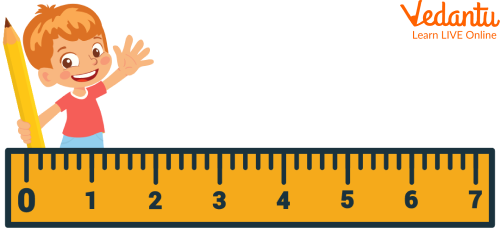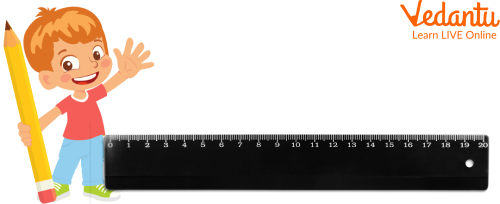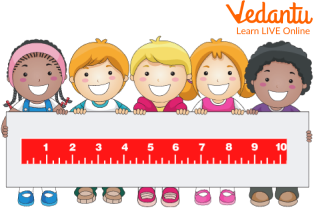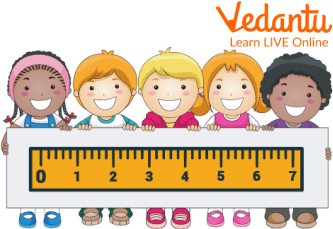




Overview of the Meter Scale
Have you ever thought about how to measure a meter? If not, then do not get impatient. This writing covers all the topics related to meter length, meter scale and measure meter. In the given article, children would gain an understanding of the concepts deeply such as how long is 1 meter and what is a meter long. The Meter scale is a very useful tool of geometry that helps students in comprehending higher levels of geometry. Now, let us start with the given topic.
What is a Meter Scale?
A meter scale is defined as a mathematical set of tools which is generally used to calculate the length of any object or thing.

Showing a Meter Scale
What does the Meter Scale Measure?
The meter scale is used to measure meters of length of an object or thing. The SI unit of measuring a length using meter scale is meter, while its CGS unit is centimeter.
How to Measure a Meter?
To measure using a meter scale, one must follow the given steps:
Take the meter scale
Put the meter scale on the starting point of the given length, object or thing
Mark the reading on the scale, where the end of the length, object or thing points
Note the reading
Thus, the measured length is obtained.

Showing the Plastic Meter Scale
What is a Meter Long?
The length of an object is measured in the units of meter, centimeter, inches, yard or feet. A meter is about 100 centimeters long in length, i.e. 1 m = 100 cm. It is about 10 decimeters long, i.e. 1 m = 10 dm.
Solved Examples
Q1. Explain the 10-decimeter length on a meter scale.
Ans: A 10 decimeter length on a meter scale describes 1 meter of length, i.e. 10 dm = 1m.

Showing 10-Decimeter Length on Decimeter Scale
Q2. What happens when we subtract or add a meter with another meter?
Ans: When a meter is added or subtracted to another meter, the result of corresponding addition and subtraction is always in meters. We can’t add meters with centimeters directly. We need to keep both in the same measuring unit (either meter or centimeter).

Showing a Wooden Meter Scale
Practice Problems
Q1. What is the meaning of 1000 meters?
Ans: 1 km
Q2. Convert 18 m length into centimeters.
Ans: 1800 cm
Q3. Can a meter be converted to another unit of measurement such as centimeter, feet, inches etc?
Ans: Yes, a meter can be converted to the corresponding centimeter, feet, inches etc by multiplying or dividing with a constant power of 10. For example: 1 cm = $\dfrac{1}{100}$ m.
Summary
Wrapping up here with the theory of meter scale and how to measure meters. It does describe how long 1 meter is? The language used in the description of the article is very easy and simple, which makes learning exciting and interesting. Some solved examples and practice problems are being given that need to be practiced by the students to gain better clarification of the topic. Feel open to implore your doubts by putting them down in the comments given below.
FAQs on Meter Scale
1. What is a meter scale?
A meter scale is a fundamental measuring instrument used to measure length. It is a straight, rigid ruler that is exactly one meter long. Its surface is graduated with standard units, typically showing markings for centimetres and millimetres, allowing for precise measurement of objects up to its full length.
2. What is the primary purpose of using a meter scale?
The primary purpose of a meter scale is to measure the distance between two points or the length of an object on a flat surface. It is also commonly used in geometry and technical drawing to draw straight lines of specific lengths. It is a standard tool in physics labs, carpentry workshops, and by tailors for measuring fabric.
3. What are the standard markings found on a meter scale?
A standard meter scale is precisely marked to show different units of length. The entire length represents 1 meter (m). This is divided into 100 equal parts, where each part is one centimetre (cm). Each centimetre is further subdivided into 10 smaller parts, with each part representing one millimetre (mm). Therefore, a meter scale has 1000 millimetre markings in total.
4. Where are meter scales commonly used in real-world applications?
Meter scales are essential tools in many fields. In science and education, they are used in physics experiments to measure distance, displacement, and focal length. In commerce, cloth merchants use them to measure fabric. In workshops, carpenters and metalworkers use them for precise cutting and assembly of materials.
5. What is the 'least count' of a standard meter scale and why is it important?
The least count of a measuring instrument is the smallest measurement that can be accurately taken with it. For a typical meter scale, the smallest marking is for a millimetre (mm). Therefore, its least count is 1 mm or 0.1 cm. This value is important as it defines the maximum precision of any measurement taken with the scale; you cannot measure a length more accurately than to the nearest millimetre using it.
6. How can you measure length correctly with a meter scale to avoid parallax error?
Parallax error occurs when your eye is not positioned correctly while taking a reading, causing the measurement to appear different. To avoid this error, you must position your eye directly above the marking being read, ensuring your line of sight is perpendicular to the surface of the meter scale. Looking from an angle (either left or right) will result in an inaccurate reading.
7. What is the main difference between a meter scale and a measuring tape?
The main differences between a meter scale and a measuring tape lie in their form and application:
- Rigidity: A meter scale is rigid and straight, making it ideal for measuring flat surfaces and drawing straight lines. A measuring tape is flexible, allowing it to measure curved surfaces or round objects.
- Portability: Measuring tapes are typically longer and can be rolled up, making them more portable for measuring larger distances. Meter scales are fixed at one meter in length.
- Application: A meter scale is preferred for lab work and technical drawings for its accuracy on flat planes. A measuring tape is used in construction, tailoring, and situations requiring flexibility.
8. Why are high-precision meter scales used in science labs often made of Invar steel?
While classroom meter scales are made of wood or plastic, high-precision scales for scientific work are often made from Invar, an alloy of iron and nickel. This is because Invar has a very low coefficient of thermal expansion. This means its length does not change significantly with changes in ambient temperature, which is crucial for experiments that require highly accurate and consistent length measurements, preventing errors due to heat or cold.









